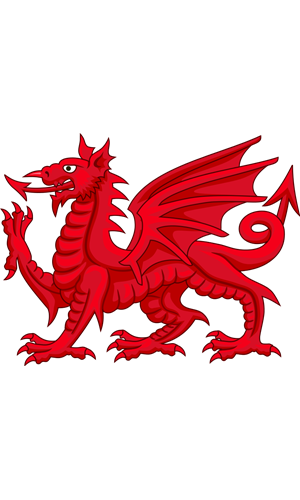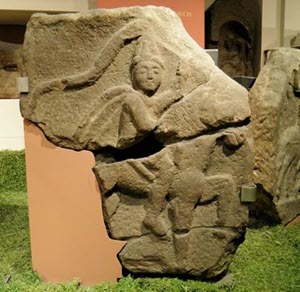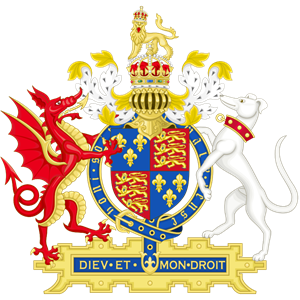The History of the Welsh Dragon
 This past month I have experienced two supposed histories of the dragon in the UK, neither of which made any reference to the one part of the country that actually has a dragon on its flag. One was a History Hit documentary from Jasmine Elmer (whom I met at HistFest earlier this year). The other was an episode of Rhianna Pratchett’s Mythical Creatures, reviewed elsewhere in this issue. This doesn’t surprise me. “British” history, as it is taught in English schools, and portrayed in the English media, tends to ignore Wales entirely unless it is being conquered by the English. Also a lot of the sources are in mediaeval Welsh which is rarely studied outside of Wales. But the story of why there is a dragon on the Welsh flag is interesting, so I’m making a stab at telling it.
This past month I have experienced two supposed histories of the dragon in the UK, neither of which made any reference to the one part of the country that actually has a dragon on its flag. One was a History Hit documentary from Jasmine Elmer (whom I met at HistFest earlier this year). The other was an episode of Rhianna Pratchett’s Mythical Creatures, reviewed elsewhere in this issue. This doesn’t surprise me. “British” history, as it is taught in English schools, and portrayed in the English media, tends to ignore Wales entirely unless it is being conquered by the English. Also a lot of the sources are in mediaeval Welsh which is rarely studied outside of Wales. But the story of why there is a dragon on the Welsh flag is interesting, so I’m making a stab at telling it.
Please note that this is very much a first pass. There is a lot of follow-up reading that I would like to do, but that requires a trip to Aberystwyth to visit the National Library of Wales, and I won’t be able to do that for a while.
Our story begins in ancient Romania and Moldova. Between the Carpathian Mountains and the Black Sea lived a people whom the Romans called Dacians. The Romanian car company, Dacia, is named after them. Their precise ethnicity is a subject of some debate as they seem to have been influenced by the Greeks to the south, the Celts to the north and the Scythians to the east, but we do know that they caused the Romans an awful lot of trouble. Domitian and Trajan both fought extensive wars against the Dacians, and though parts of their territory were conquered they continued to be a thorn in the Roman side until the late 3rd Century when Aurelian gave up and abandoned the province.
The Romans were great adopters of ideas. If any people that they incorporated into the Empire did something well, they would take that idea and make it their own. The Dacian military impressed them greatly, and one of the innovations that they adopted was a standard that the Romans called the Draco.
A Dacian draco was a metal image of a wolf’s head (the Dacians particularly revered wolves) behind which trailed a long fabric tube. The standard was carried by cavalry. At speed, the wind would rush through the draco, causing the tail to stream out and making a howling sound as it passed through the head. The Romans thought this looked like a dragon, and adopted it for their cavalry.
However, the Dacians may not have invented the draco standard themselves. They did, after all, live on the western border of Scythian lands. And if anyone was going to invent something neat involving cavalry it was the Scythians. The Greek historian, Arrian (86-160 CE approx.), said that the Romans got the idea of the draco from the Scythians, and we do know that at least some Scythians used it.
In 175 CE Marcus Aurelius scored a notable victory over a people called the Sarmatians. They were culturally Scythian and lived in the region to the north-east of the Black Sea, so bordering on Dacian territory. As part of the peace treaty, the Romans demanded the service of 8,000 Sarmatian cavalry to serve in the Roman army. Rather cruelly, he sent more than half of them to Britain.
 Being nomads, the Sarmatians probably brought their families with them, so that was a sizeable influx of steppe horse people into Britain. I’ve seen estimates of as many as 20,000 people. Recent DNA analysis of a grave in Cambridgeshire has proved that at least one of them died here. The Sarmatians were originally based at Deva (Chester) alongside Legio XX Valeria Victrix. Some of them may have been moved back to the continent, but we have evidence of one wing of the unit being based at Bremetenacum (Ribchester in Lancashire) as late as the end of the 4th Century. Famously there is a funerary monument at Chester showing a Sarmatian cavalryman carrying a draco standard.
Being nomads, the Sarmatians probably brought their families with them, so that was a sizeable influx of steppe horse people into Britain. I’ve seen estimates of as many as 20,000 people. Recent DNA analysis of a grave in Cambridgeshire has proved that at least one of them died here. The Sarmatians were originally based at Deva (Chester) alongside Legio XX Valeria Victrix. Some of them may have been moved back to the continent, but we have evidence of one wing of the unit being based at Bremetenacum (Ribchester in Lancashire) as late as the end of the 4th Century. Famously there is a funerary monument at Chester showing a Sarmatian cavalryman carrying a draco standard.
On a tangent, Herodotus tells us that the Sarmatians were descended from a group of Amazons from Themiscyra (it is a real town in northern Turkey) who got captured by maritime raiders, slew their captors and, not being very good with boats, ended up on the north shore of the Black Sea. There they made a deal with the locals, trading sex for any female babies thus resulting. The men wanted the Amazons to marry them, but the Amazons refused to live in a patriarchal society. They said that and man who wanted to continue a relationship with them must come and live with them in a gender-equal society. And this was the origin of the Sarmatians.
There were probably women warriors in the Sarmatian cavalry unit sent to Britain, because the graves of two of them were found at Brovacum (Brougham Castle in Cumbria). They were buried together with horses and weapons, and may be the first recorded lesbian couple in British history.
The Sarmatians were known to use cataphracts, heavy cavalry where both the horse and rider are covered in scale mail. However, it would have made no sense for Marcus Aurelius to send such troops to Britain. What he wanted was light cavalry who could patrol the northern border region and get to instances of trouble very quickly. Nice as it might have been for Arthuriana, our Sarmatians would have looked nothing like mediaeval knights.
But, when the Romans left, some military units may have stayed behind. Our story now moves to the region between the Hadrianic and Antonine Walls, and a people known to the Romans as the Votadini, and in Welsh as Y Gododdin. They are the subject of a famous Welsh poem (in which they were the losers in a battle with the Angles from Deira (North Yorkshire)) and in the founding myth of the Kingdom of Gwynedd. It is Gwynedd that will occupy the rest of our attention.
Legend has it that a king of the Votadini called Cunedda took his people to North Wales and founded Gwynedd. This would have been in the early 5th Century, long before the famous battle, so clearly some of the Votadini remained behind. The royal house of Gwynedd traces its descent from Cunedda.
The first King of Gwynedd we need to consider is Cadwallon I, known as Cadwallon Lawhir (Longhand) because of his very long arms. He is credited with driving the Irish out of Anglesey, allowing the island to become a stronghold for Gwynnedd from then on. I mention him for two reasons, one of which is that he is probably the Cradelmant of Norgales (North Wales) featured in the Arthur story.
The other reason is because there’s a story that I’m still trying to track claiming that, in the battle with the Irish, the Welsh tied their legs to their horses. This sounds suspiciously like someone who had never seen stirrups trying to describe them. And that’s notable because the Sarmatians are one of the two peoples vying for the credit for inventing stirrups (the other is the Chinese). There’s no evidence that the Romans used stirrups until Byzantine times, but they may have known about them.
I go on about the Sarmatians and Welsh cavalry because it is necessary to establish that Welsh cavalry existed. The Saxons, bless them, did not think much of fighting on horseback. Famously, Harold Godwinson’s crack troops rode down from Stamford Bridge to Hastings and then dismounted to fight in a shield wall. The Norman cavalry taught them a lesson about warfare. And because of this, English historians tend to assume that the Welsh knew nothing of cavalry until they saw the Normans.
However, the Romans, from Julius Caesar onwards, noted the fondness of the native Britons for chariots. We have plenty of archaeological evidence for the use of horses by people such as the Brigantes and Silures. In addition to the Sarmatians at Chester, there was a unit of Hispanic cavalry stationed at Brecon. Cadwallon Lawhir is said to have used cavalry against the Irish. There’s even a section of one of Taliesin’s poems in which the army of Urien of Rheged mocks their Pictish enemies for the smallness of their mounts, so the Welsh clearly took pains to breed quality cavalry horses. And if they inherited ideas about cavalry from the Romans, they would have known about the draco standard.
The first mention of dragons in association with Wales comes from Gildas, who was very much as grumpy as Lucy Holland portrays him in Sistersong. He made great show of excoriating various Welsh kings for their lack of bravery and moral fibre. He reserves his greatest ire for Maelgwyn of Gwynedd, who he calls the “Dragon of the Isle”. (The island in question being presumably Anglesey.)
I note in passing that the Welsh for chief dragon would be Pendraig. If Welsh cavalry were called dragons because of their standards, a Pendragon would be a leader of cavalry.
The first King of Gwynedd known to have used a dragon on his standard is Cadwalladr the Blessed, called thus because he was very pious and founded many churches. He’s not exactly the sort of figure to be associated with dragons but, as we shall see, history has made him thus. The true dragon from whom the legend descends is likely to be his father, Cadwallon ap Cadfan.
We are now very much in real history. Cadfan’s gravestone can still be seen at a church in Llangadwaladr on Anglesey. He didn’t have a great time as King of Gwynedd. During his reign, the Welsh (mainly Powys rather than Gwynedd) suffered a great defeat at the Battle of Chester at the hands of the Angles under the Northumbrian King, Æthelfrith. Perhaps because of this, Cadfan chose to foster a pretender to the Northumbrian throne, Edwin of Deira. From that, much disaster ensued.
Sharp-eyed readers will note that we are now firmly in Hild territory. Edwin is Hild’s great uncle, and a major character in Nicola Griffith’s Hild. He did, with the help of the Saxon king, Rædwald (he of Sutton Hoo), eventually overthrow Æthelfrith, and one of the first things he did on becoming king was attack Gwynedd.
So what’s up here? By this time Cadwallon was King of Gwynedd. He and Edwin would have grown up together at Cadfan’s court, and we can only assume that the two princes came to hate each other. Certainly they spent the rest of their lives in open warfare. Edwin had the initial advantage. Cadwallon was driven from Anglesey. He took refuge for a while on Ynys Seiriol (Puffin Island) at the north-eastern end of the Menai Strait, and eventually ended up in exile in Ireland.
Time passed, and Cadwallon was able to return to Britain. He found an ally in the form of Penda, King of Mercia. As we learn from Menewood, that led to the Battle of Hatfield Chase near Doncaster where Edwin was killed. Cadwallon then went on a lengthy rampage through Northumbria, looting and killing as he went. He finally met his end at the Battle of Heavenfield up near Hadrian’s wall where he was defeated by an army led by Æthelfrith’s son, Oswald (or, if you prefer, by Hild of Elmet).
Cadwallon is the main villain of Menewood, and to anyone from Northumberland, from the Venerable Bede to Griffith, that’s entirely unsurprising. However, Welsh sources, including Geoffrey of Monmouth, describe him as a great national hero. Geoffrey even has him surviving Heavenfield and living to the ripe old age of 84. A more neutral account can be found in Max Adams’ excellent book, The King in the North.
My point here is twofold. Firstly, the way that Cadwallon’s army operates suggests that it contained a significant amount of cavalry. And secondly, the way that he lays waste to Northumberland is very dragon-like.
 Mention of Geoffrey of Monmouth brings us to the famous prophecy of Merlin concerning the red and white dragons that are fighting for the future of Britain. The story also appears in the tale of Lludd & Llefelys from the Mabinogion, but Geoffrey’s work is older than any surviving Welsh-language source. This story took on particular significance during the Wars of the Roses, in which one side had a red badge and the other white. Interestingly, Edward IV claimed descent from Cadwaladr, but the Tudors had a far more believable claim. The Tudor ancestral home was the village of Penmynydd (Mountain Top) on Anglesey. Henry Tudor used a red dragon on his coat of arms to denote his descent from Cadwalladr.
Mention of Geoffrey of Monmouth brings us to the famous prophecy of Merlin concerning the red and white dragons that are fighting for the future of Britain. The story also appears in the tale of Lludd & Llefelys from the Mabinogion, but Geoffrey’s work is older than any surviving Welsh-language source. This story took on particular significance during the Wars of the Roses, in which one side had a red badge and the other white. Interestingly, Edward IV claimed descent from Cadwaladr, but the Tudors had a far more believable claim. The Tudor ancestral home was the village of Penmynydd (Mountain Top) on Anglesey. Henry Tudor used a red dragon on his coat of arms to denote his descent from Cadwalladr.
Annoyingly, Henry VIII, having grown up in London, seemed to have no particular interest in his Welsh roots, and Welsh influence over the Tudor court quickly waned. The red dragon did not officially become a symbol of Wales until the creation of the United Kingdom as we now know it in 1807. The Welsh flag was created in 1959. But the dragon on it can be traced back to Cadwalladr, and from him to the Romans and Sarmatians.
So yeah, the Welsh dragon was gifted to us by a people from the Asian steppes who claim descent from the Amazons.